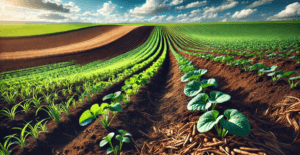Boosting Soil Health & Profits: How Conservation Agriculture Transforms Farming in Semi-Arid India
Conservation agriculture (CA) enhances soil health and crop yields, making it crucial for sustainable farming in India’s semi-arid regions. The predominant peanut-wheat cropping system faces challenges like soil degradation, moisture stress, and residue burning, reducing productivity. A study evaluated different tillage methods—conventional tillage (CT), minimum tillage (MT), and zero tillage (ZT)—along with residue management techniques such as no residue (NR), wheat stubble (WS), and wheat stubble with Cassia tora mulch (WSC).
The findings showed that ZT significantly improved soil structure by increasing macro- and micro-aggregates, while WSC enhanced water-stable aggregates (WSA) by 45.6% over NR. ZT also boosted soil carbon, organic matter, and water infiltration. Water infiltration was highest under WSC (103.8 mm/hr) and WS (102.2 mm/hr). Additionally, soil microbial biomass increased under ZT and MT, particularly in the top 0-15 cm soil layer. WSC resulted in the highest peanut pod yield (1769 kg/ha) and wheat grain yield (3623 kg/ha). Minimum tillage (MT) and WSC provided the best financial returns, approximately $970-975 per hectare.
Overall, CA practices, particularly reduced tillage and residue management, enhance soil quality, increase productivity, and improve farm profitability, offering a sustainable solution to combat soil degradation and ensure long-term agricultural success.

Boosting Soil Health & Profits: How Conservation Agriculture Transforms Farming in Semi-Arid India
In the semi-arid regions of India, farming is challenging due to dry conditions and soil degradation. Farmers commonly grow peanuts and wheat in rotation, but issues such as soil erosion, water scarcity, and the harmful practice of burning crop residues have negatively impacted yields and sustainability. To address these challenges, researchers explored conservation agriculture (CA)—a set of farming practices designed to improve soil health while enhancing productivity. Their study focused on two key aspects: tillage methods (soil preparation techniques) and crop residue management (handling plant material left after harvest). The objective was to identify strategies that enhance soil quality, conserve water, and increase farmers’ profitability.
The experiment evaluated three tillage methods:
- Conventional Tillage (CT): Traditional deep plowing.
- Minimum Tillage (MT): Reduced soil disturbance, where only the top layer is loosened.
- Zero Tillage (ZT): No plowing; seeds are sown directly into undisturbed soil.
Additionally, three residue management techniques were tested:
- No Residue (NR): Complete removal of crop remains.
- Wheat Stubble (WS): Leaving wheat stems and leaves on the field.
- Wheat Stubble + Cassia tora Mulch (WSC): Adding mulch from the drought-resistant plant Cassia tora along with wheat residue.
The results were significant. Zero Tillage (ZT) greatly improved soil structure, increasing the formation of soil aggregates—clumps essential for healthy soil. Compared to conventional tillage, ZT increased large aggregates by 89%, medium-sized aggregates by 113%, and small aggregates by 33%. These aggregates enhance water retention, reduce erosion, and support plant root development. When paired with WSC residue management, soil water-holding capacity improved by 45% compared to fields without residue, a crucial benefit in water-scarce regions.
Beyond structural improvements, ZT also boosted organic matter and carbon levels, which nourish beneficial microbes and improve soil fertility. Water infiltration—the rate at which water seeps into the soil—was highest in WSC-treated fields (103.8 mm/hour) and WS fields (102.2 mm/hour), compared to 96.7 mm/hour in residue-free plots. Faster infiltration reduces runoff and ensures better moisture retention for crops. Additionally, the topsoil (0-15 cm depth) under ZT and MT exhibited higher microbial activity, essential for nutrient cycling and plant growth.
Crop yields also showed notable improvements under the WSC approach. Peanut pod yields reached 1,769 kg per hectare, while wheat grain yields increased to 3,623 kg per hectare. In terms of overall productivity (measured as peanut-equivalent yield), WSC fields produced 3,037 kg per hectare, outperforming all other methods. This rise in yield not only enhances food security but also boosts farmers’ incomes.
From an economic perspective, Minimum Tillage (MT) combined with WSC mulch provided the highest financial returns, with profits ranging from $970 to $975 per hectare. This is particularly significant for small-scale farmers who rely on maximizing every resource. Reduced tillage lowers expenses on fuel and labor, while mulching decreases the need for irrigation and fertilizers. Over time, these cost savings contribute to greater farm profitability and sustainability.
What do these findings mean for farmers in dry regions? Adopting conservation techniques such as reduced tillage and smart residue management can help restore soil health, conserve water, and increase crop productivity. Retaining crop residues or adding Cassia tora mulch enriches the soil and protects it from harsh sunlight, reducing evaporation. Healthier soil leads to stronger plants, which can better withstand droughts and pests. Over time, these methods enhance soil fertility, reducing the reliance on chemical fertilizers and promoting sustainable farming.
In conclusion, this study provides a clear path for transforming agriculture in India’s semi-arid regions. By implementing reduced tillage and residue retention, farmers can combat soil degradation, improve water efficiency, and achieve higher yields—all while increasing profitability. These practices benefit not only agriculture but also the environment by reducing pollution from crop burning and lowering greenhouse gas emissions caused by excessive plowing. As climate change intensifies and natural resources dwindle, conservation agriculture is not just an alternative—it is essential for ensuring the future of farming.
You must be logged in to post a comment.